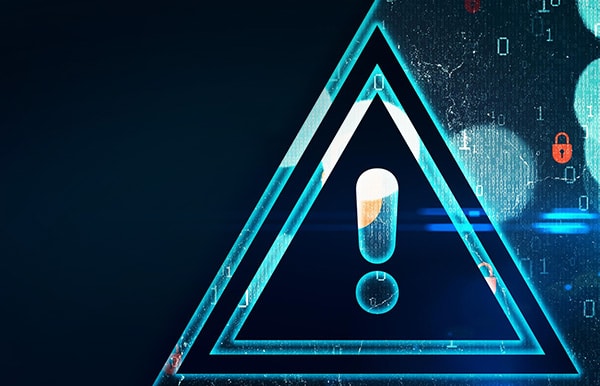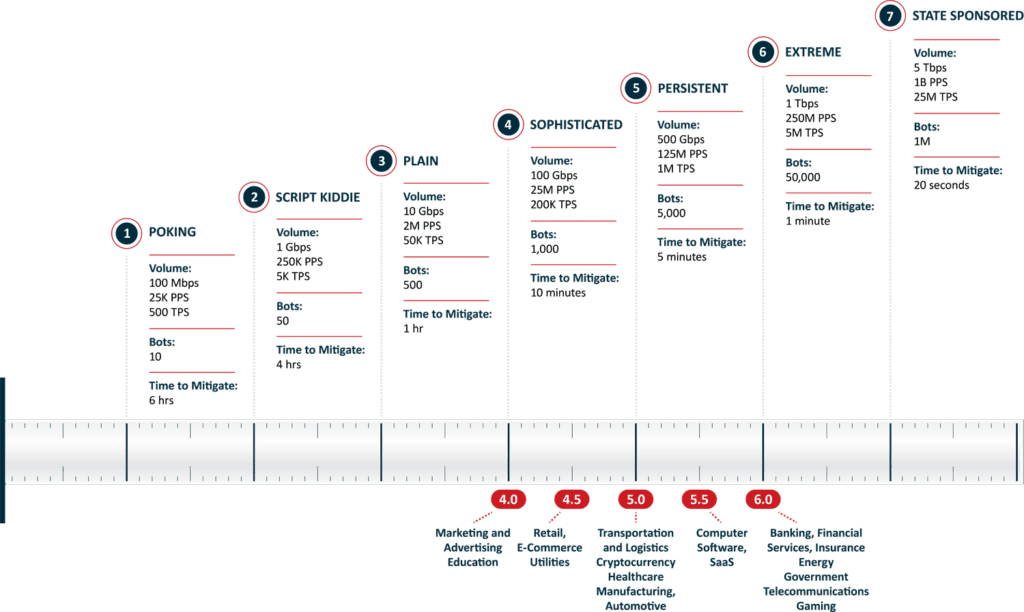Which Industries Are Most at Risk for DDoS Attacks?

Distributed Denial-of-Service (DDoS) attacks pose a significant threat to companies across various industries. But the risk is not the same for everyone. The DRS Board, the governing body behind the DDoS Resiliency Score (DRS) standard, has released its latest report detailing the relative threat level each industry faces and what organizations can do about it.
Understanding Industry Vulnerabilities
Some industries are far more frequently targeted than others due to their unique vulnerabilities and the motivations of attackers. Others may be targeted less often yet face more severe consequences if a DDoS attack is successful.
The DRS scoring mechanism is based on seven ascending levels of DDoS attacks. Each level introduces additional types of attacks, more sophisticated attack vectors, and larger volumes of traffic. Similarly, the requirements on the defending side increase, with each level requiring a shorter mitigation response time and smaller latency.
DRS Threats by Industry
According to the DRS Board report, we can break the assessed DDoS threat rankings into roughly three levels.
Higher risk (DRS of 5.5 and above):
- Businesses in the Banking, Financial Services, and Insurance sectors are at risk of critical service disruptions initiated by hacktivists and cyber extortionists.
- Energy companies face the risk of politically motivated outages caused by disruption to their critical operations, with the most likely DDoS attackers being either sophisticated hacktivists or state-sponsored adversaries.
- Government and Public Sector organizations are often targets of hacktivism and state-sponsored campaigns, especially during significant events like elections.
- Internet and Telecommunications providers are also at high risk of ransom-driven attacks, with hackers demanding payment to stop disrupting services.
- Gaming and Gambling companies are particularly vulnerable to extortion and competitor attempts to undermine them, as they depend on seamless and secure streaming operations.
- Computer Software and SaaS vendors may be hit with extortionary or adversarial DDoS attacks, leading to service degradation and a loss of customer trust.
Medium risk (DRS of 5.0):
- Transportation and Logistics organizations are sometimes subjected to short-term disruptions and nuisance extortion during DDoS campaigns.
- Cryptocurrency companies are primarily targeted by DDoS attackers interested in ransom.
- Healthcare Providers targeted by DDoS attacks typically see temporary disruption of online portals and nuisance-level extortion.
- Manufacturing and Automotive companies are at risk of DDoS attacks that disrupt operational technology and critical services.
Lower risk (DRS of 4.5 and below):
- Unscrupulous individuals in the Retail and E-Commerce industries may attempt to gain unfair advantage by paying for DDoS attacks during a competitor’s product launch.
- State-run Utilities are periodically targets of politically motivated DDoS attacks intended to disrupt operations technology and critical services.
- Marketing and Advertising agencies are known to have been targeted in DDoS attacks that cause short-term disruptions or are leveraged for nuisance extortion.
- Education sector institutions targeted in DDoS attacks tend to suffer from a temporary disruption of online portals and nuisance-level extortion attempts.
How Organizations Can Respond
Organizations can begin to take proactive steps to enhance their DDoS resilience in accordance with the industry threat assessment presented in the DRS Board report.
The financial, energy, and telecommunications sectors face the highest risk of DDoS attack and must prioritize robust protective measures. These industries, along with government entities, are frequent targets due to their critical infrastructure and data sensitivity. To mitigate these threats, organizations should invest in traffic filtering, scalable network architectures, and comprehensive emergency response plans.
Industries with medium threat levels should focus on early detection and rapid mitigation strategies. Even sectors traditionally considered lower risk – such as advertising and education – must remain vigilant and implement basic protection measures.
Proper data security protocols and system configurations are essential in all industries to guard against evolving attack patterns and ensure operational continuity.
To accurately assess your organization’s DDoS resilience, we recommend conducting specialized audits and stress tests. These detailed evaluations provide a clearer picture of vulnerabilities and help tailor your defense strategies to specific threat profiles.
How the Threat Levels are Determined
The “DDoS Threat Assessment by Industry” report takes a data-driven approach, providing a standardized score for each industry based on the DRS scale.
Manufacturer reports, DFIR activities, and observations of ongoing activities are regularly incorporated into updates of the DRS standard. The following criteria are considered:
- Attack likelihood: How frequently are companies in the industry targeted by DDoS attacks?
- Attack strength: What is the typical intensity of attacks?
- Impact: What operational and financial damages can arise from an attack?
- Resilience (DRS Score): An estimate of the industry’s average resilience against DDoS attacks.
